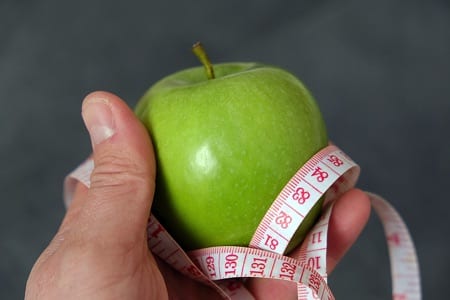 Whether you are a vegan who is seeking to lose weight, or a non-vegan wondering if a vegan diet might help you achieve your health and fitness goals, we’re going to examine everything there is to consider about this issue. There are many proven health benefits to going vegan and there is also lots of evidence that indicates that vegans are slimmer (as measured by Body Mass Index – BMI – among other things) than those who consume meat and dairy products.
Whether you are a vegan who is seeking to lose weight, or a non-vegan wondering if a vegan diet might help you achieve your health and fitness goals, we’re going to examine everything there is to consider about this issue. There are many proven health benefits to going vegan and there is also lots of evidence that indicates that vegans are slimmer (as measured by Body Mass Index – BMI – among other things) than those who consume meat and dairy products.
Here we will look at how and why vegans might be leaner and we will provide tips on how to use a vegan diet to lose weight. We have stated many times that in one regard there is no such thing as “a vegan diet”. By that we mean there is no single one-size-fits-all diet plan that all vegans follow; the only thing one vegan’s dietary habits has in common with another’s is that they both eschew animal products.
Being Vegan Doesn’t Mean You’ll Lose Weight Automatically
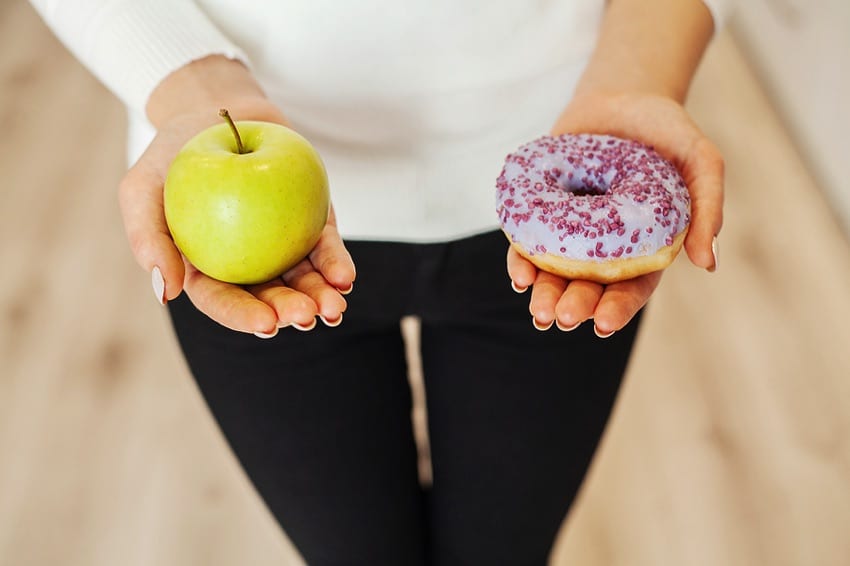
Whilst a raw vegan diet is likely to consist largely of fresh fruit, vegetables, nuts and seeds, other vegans might opt for the lesser known chocolate and vegan beer diet. Whilst adherents of such eating regimes are both on “a vegan diet”, clearly they are likely to have very different health outcomes and would probably have rather different BMIs (all other things being equal).
Our point here is that simply by becoming vegan you will not magically get the body of a world-beating vegan athlete. Going vegan will definitely help the environment and, of course, it will prevent many animals from being killed or forced to endure suffering. But no longer eating meat, eggs, dairy and other animal products will not suddenly make your abs appear more pronounced or help you drop two dress sizes.
Do Vegans Have a Lower BMI?
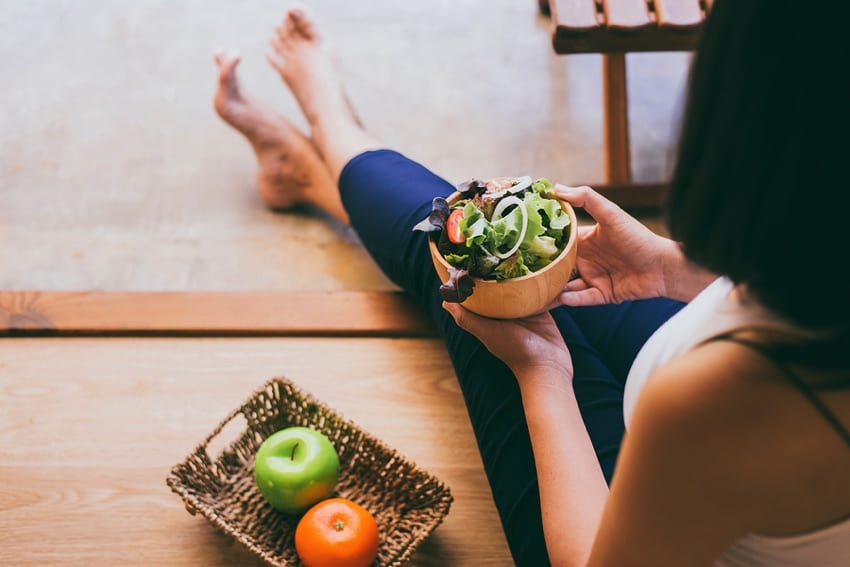
So, if simply being vegan won’t automatically make you lose weight, is a plant-based diet a good choice for a non-vegan who has such aspirations? How do we square up the notion that vegans in general have lower BMIs and less body fat and yet being vegan won’t necessarily lead to such an outcome? And, is it even true that vegans are slimmer (as measured by those and other similar metrics)?
Let’s look at that last point first, because if that assumption isn’t even true then we need consider the issue no more. So, are vegans thinner? Well, quite simply, yes. There are many studies that look at this issue and whilst they don’t necessarily show causality, they do show a correlation between being vegan (and to a lesser extent vegetarian) and having a lower BMI.
EPIC-Oxford Study
One of the biggest pieces of research was the EPIC-Oxford Study, published in the International Journal of Obesity, which looked at almost 38,000 people. That’s a significant sample size and the BMI stats were adjusted for age too, which further improves their value as it negates any argument that vegans may be slimmer because they tend to be younger. It also looked at other non-dietary factors and concluded that:
Differences in lifestyle factors including smoking, physical activity and education level accounted for less than 5% of the difference in mean age-adjusted BMI between meat-eaters and vegans.
In other words, diet was the thing that best explained the differences in weight. The study began with almost 60,000 participants but some were excluded for a range of reasons (including medical conditions). Research took place over seven years and considered four diets, concluding that “Fish-eaters, vegetarians and especially vegans had lower BMI than meat-eaters.” The figures for each group are shown in the table below:
Comparing BMI by Diet
| Diet | Male BMI | Female BMI |
|---|---|---|
| Vegan | 22.53 | 22.01 |
| Vegetarian | 23.38 | 22.73 |
| Fish-eater | 23.35 | 22.70 |
| Meat Eater | 24.39 | 23.49 |
Note that the stats shown above are adjusted for age and the following lifestyle factors: ethnicity, smoking, education, physical activity, marital status, and (for women only) parity (i.e. the number of children).
Whilst BMI does not always tell the full picture and is in some ways something of a blunt tool, it is still one of the best, simplest indicators of health and it is a good predictor of longevity and outcome in relation to a range of diseases and illnesses. The EPIC-Oxford Study is one of the most respected in this area and was carried out by the University of Oxford as part of a wider European research initiative. This research clearly shows that in general vegans have lower BMIs than people in other dietary groups.
Study by the American Diabetes Association
As said, this particular study is not unique and others support its findings. One such piece of research was published in the US National Library of Medicine’s National Institutes of Health having been carried out by the American Diabetes Association. With a sample of more than 60,000 men and women, over a period of five years (2002-2006) it found a similar pattern, albeit with slightly higher BMI levels and different dietary categories.
Comparing BMI by Diet
| Diet | Unadjusted BMI |
|---|---|
| Vegan | 23.6 |
| Lacto-ovo vegetarian | 25.7 |
| Pesco-vegetarian | 26.3 |
| Semi-vegetarian | 27.3 |
| Non-vegetarian | 28.8 |
This study shows an even more marked difference in the benefits of the vegan diet in terms of maintaining a healthy weight and indeed its conclusion stated that, “only vegan diets were associated with a BMI in the optimal range”. The final line of the entire report stated:
In conclusion, this study showed that all variants of vegetarian diets (vegan, lacto-ovo, and pesco- and semi-vegetarian) were associated with substantially lower risk of type 2 diabetes and lower BMI than non-vegetarian diets. The protection afforded by vegan and lacto-ovo vegetarian diets was strongest.
Why Do Vegans Have Lower BMI?
Having established that vegans as a group have a lower BMI than followers of other diets, we return to the issue of why simply going vegan will not, in and of itself, make you lose weight. Quite simply, as we have said, there are healthy vegan diets and unhealthy vegan diets.
In some circumstances, there could be many factors influencing a person or group’s BMI but it seems sensible that diet would be one of the most important, an assumption backed up by the EPIC-Oxford Study. Many unhealthy foods – ones that are high in sugar, fat and calories, and low in nutritional value – tend to be non-vegan. On the other side of the coin, many of the most nutrient-dense foods that pack a powerful vitamin and mineral punch, especially relative to their calorific content, are naturally vegan.
There are, of course, many healthy, nutritious and low calorie foods that are non-vegan and lots of plant-based items that are unhealthy, have a low nutritional value and are high in calories. So once again, we return to that phrase: in general.
Traditional Food Pyramid Built on Vegan Foundations
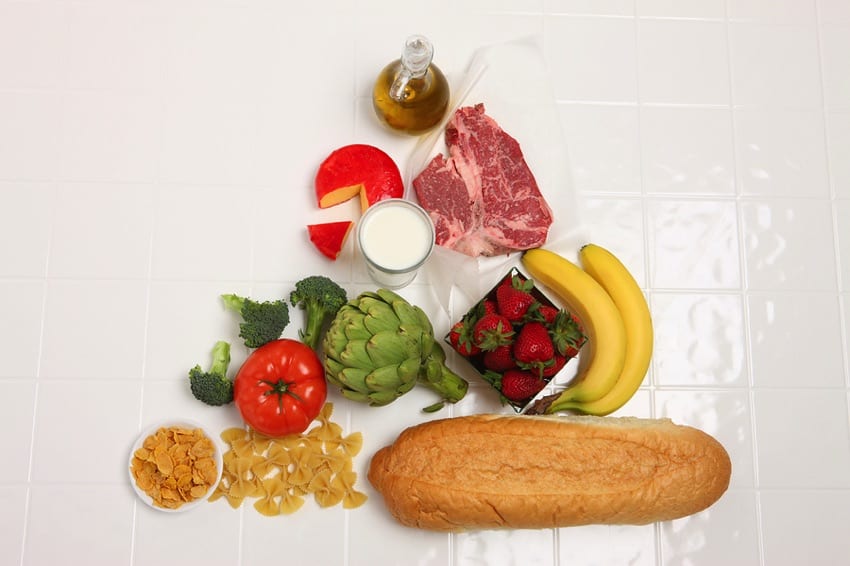
The concept of a food pyramid as a simple visual guide to a healthy diet has been around a long time. Not as long as the pyramids of Egypt, but long enough. There are variations on this idea, such as the NHS Eat Well concept, which uses a plate to help people visualise what percentage of their overall diet should be made up of what types of foods.
There are variations on the exact structure of the pyramid too, with different nations having slightly different ideas of what makes a balanced diet and this information changing over time too, as discussed at Safefood, a “body set up under the British-Irish Agreement with a general remit to promote awareness and knowledge of food safety and nutrition issues on the island of Ireland.”
Healthy Base Consists of Vegan Foods
In any food pyramid, the groups at the bottom of the structure can and should be eaten more freely, whilst those at the top should only be consumed in moderation or even only occasionally. If we look at Safefood’s updated (December 2016) data, the biggest part of the pyramid, the bottom layer, is fruit, salad and vegetables, with five to seven portions per day recommended.
The second biggest tier consists of “wholemeal cereals and breads, potatoes, pasta and rice”. Three to five servings from this “shelf” are recommended, with a serving equating to around 150 calories. Above this level is a “shelf” of milk, yoghurt and cheese, typically assumed to be of dairy origin. Next comes “Meat, poultry, fish, eggs, beans and nuts”, with fats/spreads above that and “Foods and drinks high in fat, sugar and salt” at the very top, with a maximum consumption level of just once or twice a week.
So, as we can see, the foundation of the pyramid is vegan by nature, with vegetables and fruits forming the biggest part of a healthy diet. Starchy items come next, ideally wholegrain, and whilst not all bread is vegan, and the same applies to some pasta, most is in both case. Moreover rice, potatoes and similar starchy carbs are always vegan.
Top of the Pyramid Generally Not Vegan
Higher up the pyramid we find many non-vegan items, such as dairy, meat and eggs, whilst the top level of the graphic lists sits “Foods and drinks high in fat, sugar and salt”. These are not vegan per se but on closer inspection, Safefood list as examples of foods in this category:
- Chocolate
- Crisps
- Cakes
- Muffins
- Biscuits
- Sugary Drinks
- Ice Cream
- Chips
The Is it Vegan? area of our site looks at many of these and whilst some are generally not vegan and there are vegan alternatives for others, most are normally non-vegan. Much chocolate, and most cakes, muffins, biscuits, pastries and ice cream, usually contain milk, butter, cream or eggs, or even all four!
So, in short, whilst the healthy base of the pyramid is where you’ll find many vegan foods, at the other end of the spectrum the majority of options are non-vegan. The simple fact is that in general an average vegan diet is likely to be healthier than an average non-vegan one and this, we feel, explains why vegans as a sub-population, have a lower BMI.
How to Lose Weight on a Vegan Diet
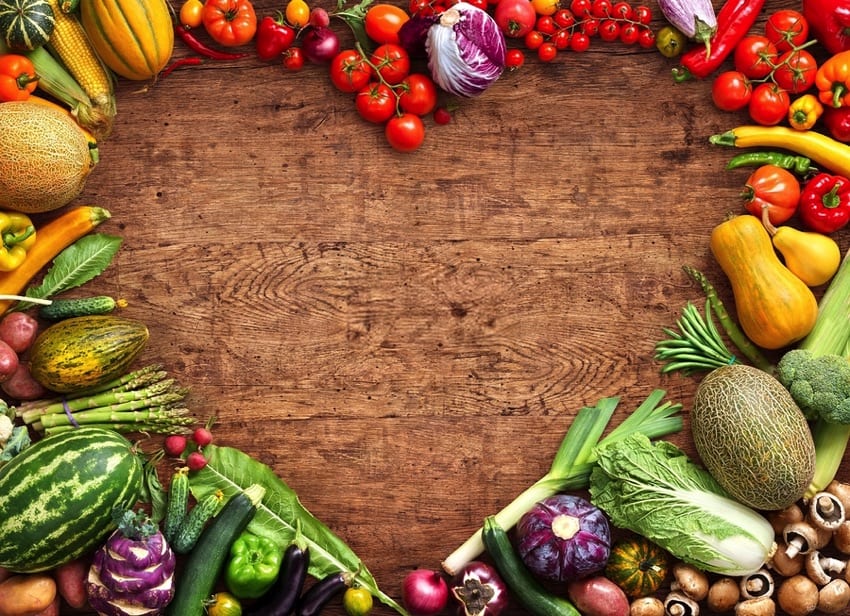
Whether you are a vegan already or considering becoming one, both losing weight and eating healthily is perfectly possible on a vegan diet. There are many concerns about following a plant-based regime but as we have said time and again on this site, most of these are stimulated by scare stories in the tabloid press that are more interested in generating clicks and views than reporting the facts.
A well-planned vegan diet can easily provide enough protein and all of the various micronutrients the body needs. For those with particular dietary needs or who may struggle to obtain certain nutrients, there are lots of excellent vegan supplements available too.
It is beyond the scope of our site to provide a full weight-loss plan but speaking to your doctor and/or a nutrition professional is a good place to start. The simple adage of “move more, eat less” is also fine advice and incorporating regular exercise alongside your new vegan diet is sure to help you lose weight, get fitter and improve both your physical and mental health. Beyond that, here are some tips and a few things to be aware of.
Nuts & Seeds: Remember Portion Control
Nuts and seeds are unheralded super foods that contain so much goodness, including healthy fats, vitamins and minerals. But healthy though those fats may be, they are still fats and that means lots of calories. If you are looking to lose weight, eating fewer calories is going to be key and so eating nuts in moderation is very sensible.
There is no definitive answer as to the optimal amount of nuts to eat but in the UK most experts appear to agree that around an ounce a day is good. That’s 28g, or around 25 almonds, or, if you have small hands, around a handful! The reason that portion control is so crucial is that even a small handful serves up a lot of calories, as you can see from the table below.
| Nut | Calories (per 28g) | Fat (per 28g) |
|---|---|---|
| Cashews | 161 | 13 |
| Walnuts | 190 | 18 |
| Almonds | 164 | 14 |
| Peanuts | 161 | 14 |
| Brazil | 193 | 19 |
| Pistachio | 154 | 13 |
| Hazelnuts | 178 | 17 |
| Pecan | 196 | 20 |
When it comes to seeds, it is a similar picture, with these little goodies packed with micronutrients but also typically delivering well over 100 calories and often more than 10g of fat. Seeds are generally lower in both energy and fat than nuts and often a little higher in protein, so some may consider seeds to be the healthier option.
People hear or read, “nuts and seeds are a healthy snack” and whilst they are undoubtedly a better pick than chocolate or crisps, because the calories are not “empty”, they may often contain more calories and more fat than people realise.
Eat More Veg Than Fruit
Most pyramids and balanced plates lump all fruit and veg together when, in truth, some are far more nutritious than others and some are far more calorific than others. Eating lots of fruit and veg is great and the more different types of them you eat, the better, as you are more likely to be obtaining all the various vitamins and minerals your body needs.
That said, leafy greens, including spinach, spring greens, kale, broccoli and others are the ones to really fill up on. Not only are they linked with many health benefits but they are also generally lower in both calories and sugar than lots of other options. In general, vegetables are going to be a better option than fruit and whilst we would not advise against eating any fruit or veg, the table below gives you an idea of which might be most helpful in trying to lose weight and which might hold you back.
Calories in Fruit & Veg
| Food (100g) | Calories | Sugar |
|---|---|---|
| Broccoli | 34 | 1.7g |
| Kale | 49 | 1.3g |
| Cauliflower | 25 | 1.9g |
| Spinach | 23 | 0.4g |
| Grapefruit | 42 | 7g |
| Sweet potato | 86 | 4.2g |
| Grapes | 67 | 16g |
| Mango | 60 | 14g |
| Avocado | 160 | 0.7g |
Replace (Some) Carbs with Veg & Protein
Whilst complex carbohydrates, ideally from whole grains, should form a significant part of most people’s daily calorific intake, for people looking to lose weight it is perhaps the macronutrient to target. Maintaining your protein levels is important as this helps increase satiety and is vital for maintaining lean body mass. Reducing fat intake is a good option but some of the calorie reduction should definitely come from complex carbs (and also simple carbs), although ideally we shouldn’t be consuming too many of these anyway.
One great way to do that whilst also increasing your protein, getting more of your “five a day” and getting a really wide range of micronutrients is to be smart about what carbs you use. Some good carbohydrate sources, such as quinoa, teff, wild rice and whole rye are much higher in protein, and often fibre and minerals too, than some other complex carbs, such as potatoes, white pasta, rice or bread.
Eating more of these is a good way to help you lose weight and maintain muscle and if you aren’t a fan of such foods, mixing them 50/50, for example half rice and half quinoa, is a good way to ease them into your diet. Lentils and other legumes are also a great option in this regard and are perfect to mix in with rice, upping the intake of protein and fibre and reducing the carbs.
Another even better option and a great way to cut calories whilst still feeling as though you are getting that carb hit and bulk, is to use veg to simulate things like rice, couscous, potatoes and even pasta. Cauliflower rice or couscous is a great choice, whilst “spiralised” veg are a low carb, low calorie alternative to pasta. Having mashed swede and carrots is a good alternative to “normal” mash and goes very nicely with some vegan sausages, whilst sweet potato offers a lower GI, lower calorie variation, as well.
As well as providing more micronutrients, switches like these can reduce the overall calories in a meal significantly, whilst still giving you the sensation of consuming carbs. As an example, a cup of cauliflower rice will deliver just 25 calories, whilst the same amount of brown rice provides around 215, which is a huge difference. Similarly, whilst 250g of raw swede has just 95 calories, the same amount of potato has 193.
As before, mixing things up – say 50% potato, 25% swede, 25% carrot – is a good way to get your taste buds used to this whilst also giving you a wider range of nutrients.
Find Something That Works for You
As with any diet, exercise regime or lifestyle change, the key thing is finding what works best for you. Information about the best vegan weight loss plan in the world is no good if you don’t use it and it doesn’t work for you. You need to figure out what healthy vegan foods you most enjoy and what your potential challenges might be.
It is also important to find a vegan weight loss diet that is compatible with the other people in your household. Forcing everyone to eat the same as you may not necessarily go down so well but there are ways round that which will still allow you to lose weight on a healthy vegan diet.
Intermittent fasting is a good option in this regard and there are many different forms of this. Whilst eating breakfast has long been considered crucial to maintaining a healthy weight, lots of alternative research suggests this may not be necessary. Whilst the science behind intermittent fasting is disputed in some quarters, if you, for example, only eat between 12pm and 8pm each day, you are reducing your options for snacking and also essentially missing breakfast.
The reduction of 200 to 400 calories that you would otherwise be consuming is perfect for slow, sustainable weight loss, whilst everyone else in your house can have their usual breakfast. If you then eat normally throughout the rest of the day the disruption to meal planning is minimal.
Another good option, linked to eating more vegetables and fewer carbs, is to simply cook a little bit more veg than normal and reapportion diners’ plates according to their aims. Give those looking to lose weight a few more veggies and a little bit less rice or potatoes and once again you manage to reduce their intake of energy with the minimum of fuss or effort.
Vegan Weight Loss Conclusion
Whether you are a vegan looking to lose weight or a non-vegan looking to a plant-based diet to help you reduce BMI and body fat, eating clean and green is a great way to get mean and lean. You don’t even have to get all that mean if you don’t want to. Simply stacking your plate with lots of great vegetables and eating a well-planned, balanced vegan diet, is sure to see you drop those pounds, get healthier and feel better in general.
You’ll automatically be cutting out lots of high-fat foods, many, such as pastries, cakes and biscuits which are also high in sugar, whilst simultaneously eating more fruit, veg, legumes and healthy whole grains. Good luck!